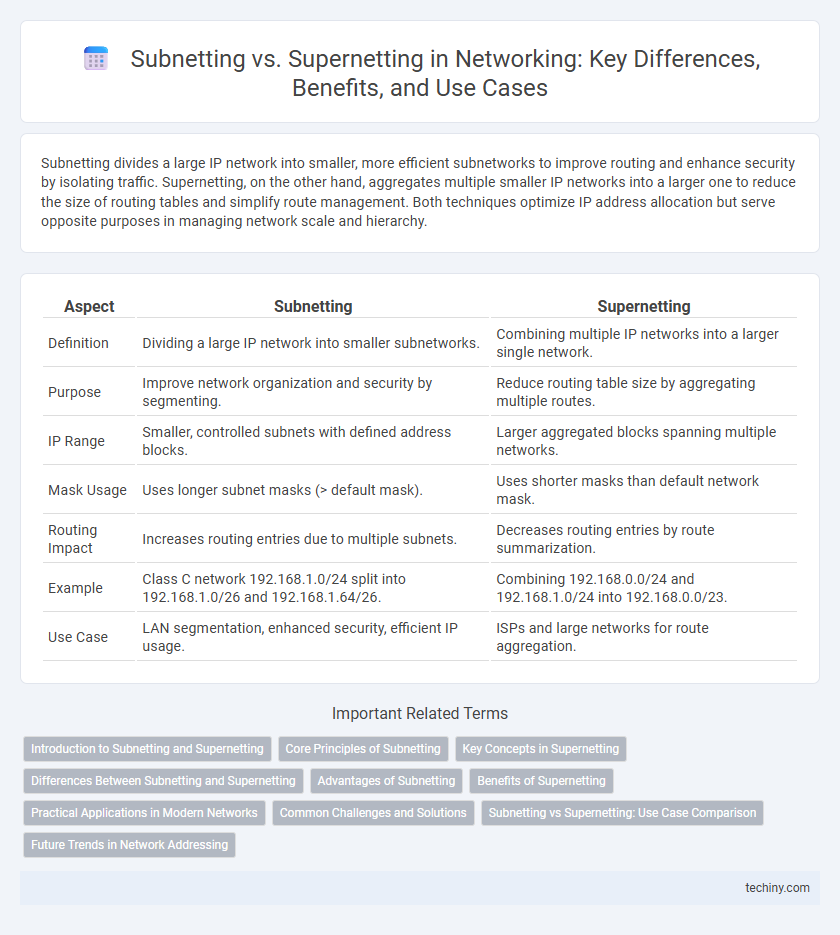Subnetting divides a large IP network into smaller, more efficient subnetworks to improve routing and enhance security by isolating traffic. Supernetting, on the other hand, aggregates multiple smaller IP networks into a larger one to reduce the size of routing tables and simplify route management. Both techniques optimize IP address allocation but serve opposite purposes in managing network scale and hierarchy.
Table of Comparison
| Aspect | Subnetting | Supernetting |
|---|---|---|
| Definition | Dividing a large IP network into smaller subnetworks. | Combining multiple IP networks into a larger single network. |
| Purpose | Improve network organization and security by segmenting. | Reduce routing table size by aggregating multiple routes. |
| IP Range | Smaller, controlled subnets with defined address blocks. | Larger aggregated blocks spanning multiple networks. |
| Mask Usage | Uses longer subnet masks (> default mask). | Uses shorter masks than default network mask. |
| Routing Impact | Increases routing entries due to multiple subnets. | Decreases routing entries by route summarization. |
| Example | Class C network 192.168.1.0/24 split into 192.168.1.0/26 and 192.168.1.64/26. | Combining 192.168.0.0/24 and 192.168.1.0/24 into 192.168.0.0/23. |
| Use Case | LAN segmentation, enhanced security, efficient IP usage. | ISPs and large networks for route aggregation. |
Introduction to Subnetting and Supernetting
Subnetting divides a larger IP network into smaller, manageable sub-networks, improving routing efficiency and enhancing security by isolating segments. Supernetting aggregates multiple contiguous smaller networks into a single larger network, simplifying routing tables and optimizing address allocation. Understanding subnet and supernet masks is crucial for efficient IP address management and network design.
Core Principles of Subnetting
Subnetting divides a larger IP network into smaller, manageable subnetworks to improve routing efficiency and enhance security within an organization. It uses subnet masks to segment the IP address space, allowing precise control over host allocation and reducing broadcast domains. Effective subnetting optimizes network performance by minimizing congestion and simplifying traffic management across distributed devices.
Key Concepts in Supernetting
Supernetting involves combining multiple contiguous subnets into a larger network to optimize routing and reduce the size of routing tables. It uses a shorter subnet mask, known as a supernet mask, which aggregates IP address blocks and improves network efficiency by enabling route summarization. This technique is essential for Internet Service Providers and large networks to minimize routing complexity and enhance scalability.
Differences Between Subnetting and Supernetting
Subnetting involves dividing a single network into multiple smaller sub-networks to improve routing efficiency and enhance security by allocating IP addresses more precisely within a defined range. Supernetting aggregates multiple smaller networks into a larger one by combining contiguous IP address blocks, which reduces the size of routing tables and simplifies IP address management. The key difference lies in subnetting creating more networks from one, whereas supernetting merges several networks into a broader address space, impacting routing strategies and address allocation accordingly.
Advantages of Subnetting
Subnetting enhances network security by isolating segments, reducing the risk of unauthorized access and limiting broadcast domains, which improves overall network performance. It allows efficient IP address management by dividing a large network into smaller, manageable sub-networks, optimizing resource allocation and reducing waste of IP addresses. Network administrators gain better control over traffic flow and can simplify troubleshooting within smaller subnetworks, ensuring faster identification and resolution of issues.
Benefits of Supernetting
Supernetting enhances routing efficiency by aggregating multiple smaller networks into a single, larger address block, reducing the size of routing tables and minimizing router processing overhead. It improves IP address utilization by allowing for the allocation of contiguous address spaces, facilitating simpler network designs and better scalability. Network administrators benefit from supernetting through streamlined route summarization, which optimizes bandwidth and enhances overall network performance.
Practical Applications in Modern Networks
Subnetting enables efficient IP address allocation by dividing a larger network into smaller, manageable segments, improving security and reducing broadcast traffic in modern enterprise networks. Supernetting aggregates multiple smaller networks into a larger IP block, optimizing routing tables and conserving IP addresses within ISP backbone networks and large-scale cloud environments. Both techniques play critical roles in scalable network design, addressing, and management amidst growing internet demands.
Common Challenges and Solutions
Subnetting and supernetting both face challenges such as efficient IP address allocation and minimizing routing table entries, which can lead to network complexity and performance issues. Common solutions include using Variable Length Subnet Masking (VLSM) to optimize subnet sizes and adopting Classless Inter-Domain Routing (CIDR) to aggregate routes effectively. Proper network design combined with automated management tools helps mitigate risks like IP address exhaustion and routing inefficiencies.
Subnetting vs Supernetting: Use Case Comparison
Subnetting is primarily used to divide a large network into smaller, manageable sub-networks to improve security, reduce congestion, and simplify management within an organization. Supernetting combines multiple smaller networks into a larger one, optimizing routing and reducing the size of routing tables for service providers and internet backbone networks. Subnetting suits internal network segmentation, while supernetting is ideal for aggregating address spaces in large-scale network routing scenarios.
Future Trends in Network Addressing
Future trends in network addressing emphasize greater flexibility through dynamic subnetting and supernetting techniques to optimize IP address allocation amid exponential device growth. Advanced algorithms and AI-driven tools enable automated and adaptive subnet mask adjustments, enhancing network scalability and reducing configuration errors. The integration of IPv6 with evolving supernetting strategies is set to address the limitations of IPv4, supporting seamless expansion for next-generation networks.
Subnetting vs Supernetting Infographic

 techiny.com
techiny.com